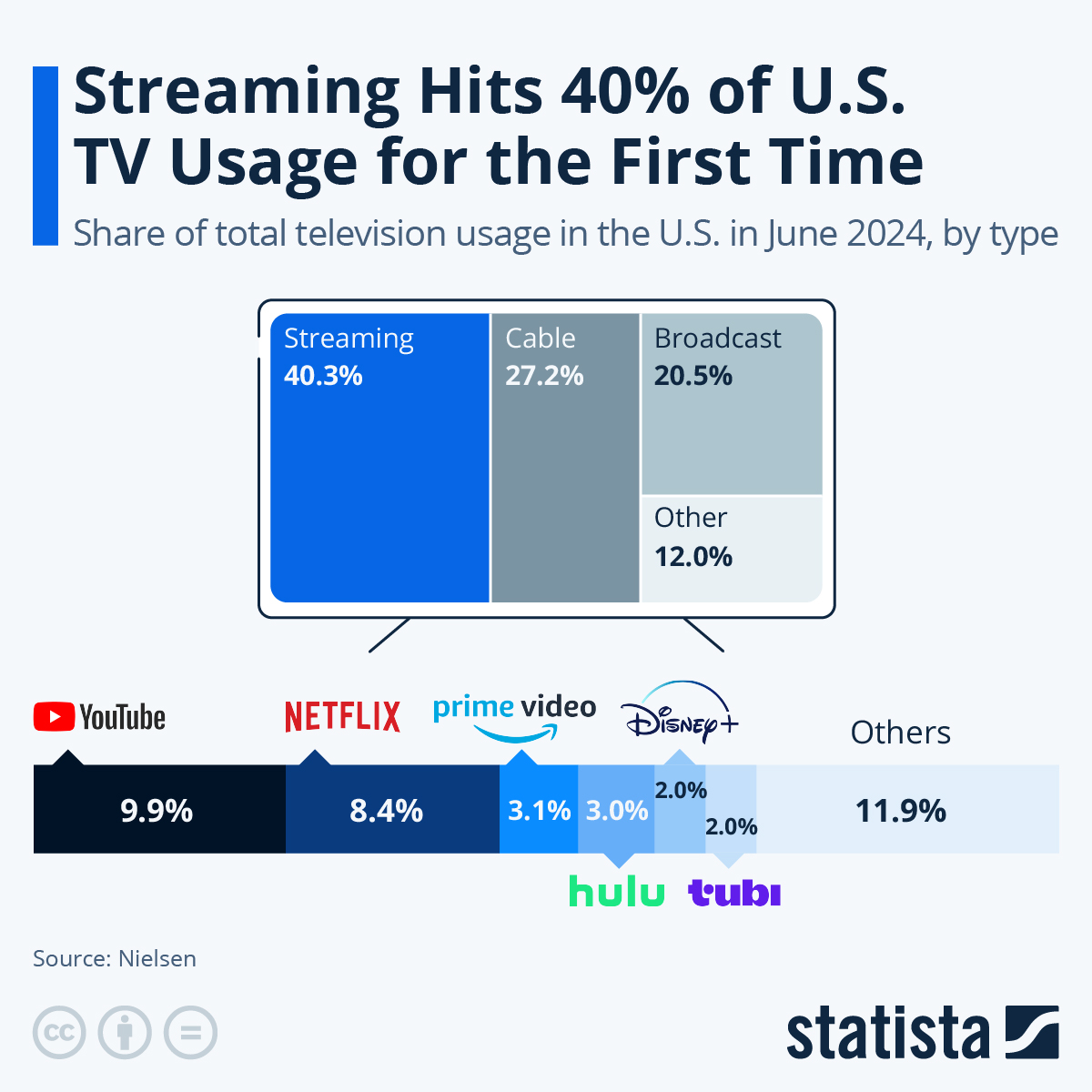
If any further proof of streaming's leading role in today's television landscape was needed, then here it is...
As Statista's Felx Richter reports, according to Nielsen’s The Gauge - a monthly report on TV viewing behavior in the United States, streaming services reached a record share of 40.3 percent of TV usage in the United States last month, leaving cable and broadcast far behind at 27.2 and 20.5 percent, respectively.
You will find more infographics at Statista
It's been two years since streaming first surpassed cable TV in July 2022 and, aside for some seasonal fluctuations, its share of TV viewing has continued growing steadily since then.
According to Nielsen, it's typical for linear TV to see a lull in viewership during the summer months, which partly explains the 1.5 percentage point increase in streaming's viewing share last month. Moreover, the start of the summer break for kids and teenagers has also contributed to the absolute and relative increase in streaming consumption, as streaming makes up a larger share of young viewers' television time, giving the category a disproportionate bump compared to broadcast and cable. Looking ahead, the Paris Olympics could throw linear TV a lifeline in July and August, as live sports remain one of the last strongholds of broadcast and cable networks.
Beginning with the success of Netflix‘s all-you-can stream model, there has been a dramatic shift in TV consumption over the past decade. Consumers quickly came to appreciate the flexibility, ease-of-use and affordability of Netflix and other streaming services that inevitably followed, making life increasingly hard for broadcast TV networks, cable TV providers and traditional pay-TV channels such as HBO. As more and more media companies jumped on the streaming bandwagon, consumers now have a plethora of choices, no matter if they prefer movies and series (Netflix, Disney+, Prime Video, etc.), documentaries (Discovery+ and others) or sports (ESPN+, DAZN).
If any further proof of streaming’s leading role in today’s television landscape was needed, then here it is…
As Statista’s Felx Richter reports, according to Nielsen’s The Gauge – a monthly report on TV viewing behavior in the United States, streaming services reached a record share of 40.3 percent of TV usage in the United States last month, leaving cable and broadcast far behind at 27.2 and 20.5 percent, respectively.
You will find more infographics at Statista
It’s been two years since streaming first surpassed cable TV in July 2022 and, aside for some seasonal fluctuations, its share of TV viewing has continued growing steadily since then.
According to Nielsen, it’s typical for linear TV to see a lull in viewership during the summer months, which partly explains the 1.5 percentage point increase in streaming’s viewing share last month. Moreover, the start of the summer break for kids and teenagers has also contributed to the absolute and relative increase in streaming consumption, as streaming makes up a larger share of young viewers’ television time, giving the category a disproportionate bump compared to broadcast and cable. Looking ahead, the Paris Olympics could throw linear TV a lifeline in July and August, as live sports remain one of the last strongholds of broadcast and cable networks.
Beginning with the success of Netflix‘s all-you-can stream model, there has been a dramatic shift in TV consumption over the past decade. Consumers quickly came to appreciate the flexibility, ease-of-use and affordability of Netflix and other streaming services that inevitably followed, making life increasingly hard for broadcast TV networks, cable TV providers and traditional pay-TV channels such as HBO. As more and more media companies jumped on the streaming bandwagon, consumers now have a plethora of choices, no matter if they prefer movies and series (Netflix, Disney+, Prime Video, etc.), documentaries (Discovery+ and others) or sports (ESPN+, DAZN).
Loading…




